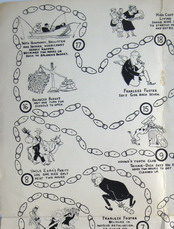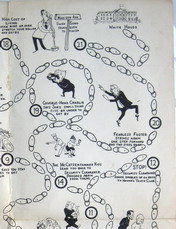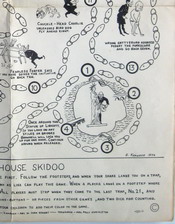Giochi dell'Oca e di percorso
(by Luigi Ciompi & Adrian Seville)
(by Luigi Ciompi & Adrian Seville)

|
Giochi dell'Oca e di percorso
(by Luigi Ciompi & Adrian Seville) |

|
 |

Torna alla ricerca giochi (back to game search) |
 |
| White House Skidoo | ||
 |
Versione stampabile
 |
Invia una segnalazione

|
    |
primo autore: | Kanarek E. |
| secondo autore: | Kanarek E. | |
| anno: | 1956 | |
| luogo: |
USA - Washington |
|
| periodo: | XX secolo (3°/4) | |
| percorso: | Percorso di 21 caselle numerate | |
| materiale: | carta (paper) (papier) | |
| dimensioni: | 600X460 | |
| stampa: | Litografia | |
| luogo acquisto: | ||
| data acquisto: | ||
| dimensioni confezione: | ||
| numero caselle: | 21 | |
| categoria: | Politica, satira, fatti di cronaca | |
| tipo di gioco: | Gioco di percorso | |
| editore: | Distributed by District of Columbia Democratic Women's Day Committee | |
| stampatore: | Non indicato | |
| proprietario: | Collezione A. Seville | |
| autore delle foto: | A. Seville | |
| numero di catalogo: | 2285 | |
| descrizione: |
Gioco di 21 caselle numerate. In basso: Distributed by District of Columbia Democratic Women's Day Committee-Chairman-Mrs. W. Joan Kenney-Treasurer-Mrs. Polly Shackleton. REGOLE: in basso. CASELLE: alcune con didascalia. REFERENZA 1 Text at very bottom below game rules "Distributed By District Of Columbia Democratic Women's Day Committee-Chairman Mrs. W. John Kenney-Treasurer Mrs. Pauly Schackleton." Copyright 1956 by E. Kanarek. Object of the game is to follow the footprints to the White House. Adlai Stevenson is seen riding a donkey at starting line. Each footstep through out the game shows a hole in the sole of the shoe referring to Stevenson's shoes. Many political figures are referenced including "Trickie Dick (Nixon) Trys New Cloth Coat Of Many Colors, Dixon-Yates Give Yourself A Bonus, With Humphrey, Hollister and Hoover Hurricanes Hardly Happen, etc." Ike is seen with golf club as Abe Lincoln looks on with caption "Wrong Gettysburg Address Forget The Forescore And Go Back Seven." "Fearless Foster" is referenced four times. McCarthy is the inspiration for the "McCatzenjammer Kids." A fun look at the politics of 1956. REFERENZA 2 Game 48: White House Skidoo E. Kanarek. White House Skidoo. Washington, DC: District of Columbia Democratic Women’s Day Committee, 1956. Lithograph, 60 x 46 cm. The object of the game, which is ”especially rigged so a Republican can’t win,” is ”to get your man in the White House first.” The game was distributed by the District of Columbia Democratic Women’s Day Committee (Chairman Mrs. W. John Kenney, Treasurer Mrs. Polly Shackleton). Mrs Kenney’s husband was William John Kenney (1904–92), a high-power Washington attorney who had been the operating chief of the Marshall Plan 1950–52. Polly Erlich Shackleton (c. 1910 - 97) was a Democratic politician in her own right and was actively involved in Adlai Stevenson’s presidential campaigns, first in 1952 then, as here, in 1956. Later, she was elected as one of the original members of the Council of the District of Columbia in 1974 when DC gained home rule. The cartoon was drawn by E[lias] Kanarek (1901–69), an artist and son of a land-owning family that was active in the Polish peasant movement. In 1938, Kanarek was sent to the U.S. by the Polish government to paint murals for the Polish Pavilion at New York City's World Fair. He remained in the U.S., where he painted portraits of and murals for notable individuals, including a wood engraving of George C. Marshall. Despite the best endeavors of the campaign, the result of the 1956 presidential election was never in doubt: a landslide for the popular Republican incumbent, Dwight D. Eisenhower, who defeated Democrat Adlai Stevenson, just as he had done previously in 1952. In Eisenhower’s favor, the Korean War had ended and the economy was doing well, while Stevenson held no public office and lacked a strong base. In this game, the bad guys are, of course, Republicans. At the hazard circles 1 - 4, [Herbert] Brownell ”will lock you up” - he was Eisenhower’s attorney general. At 5 is “Trickie Dick” in a ”coat of many colors”: Eisenhower’s vice president Richard Nixon, the nickname dating from newspaper coverage of the California Senate election of 1950. At circle 6, the reference is to the Dixon-Yates contract for electricity supply in Tennessee, a bone of contention between the parties. At 7, is Fearless Foster: John Foster Dulles served as U.S. secretary of state from 1953 to 1959, advocating an aggressive stance against communism; the instruction is to ”go ahead 6.” At circle 8 is “Uncle Ezra’s party,” showing a hayseed with cow, with the instruction to use only a single dice for the next two turns. Ezra Taft Benson was an American farmer and leader of the Church of Jesus Christ of Latter-day Saints and was secretary of agriculture during both presidential terms of Eisenhower. At circle 9 is the Hound’s Tooth Club. In 1952, there was a report that Nixon had established a millionaires’ club to pay his expenses; Eisenhower responded by telling the press that the Republican campaign must be ”whiter than a hound’s tooth.” At circle 11 is Chuckle Head Charlie, Defense Secretary Charles E. Wilson, who made an insensitive comment about unemployment in 1954: “But I have always liked bird dogs better than kennel-fed dogs myself - you know, one that will get out and hunt for food rather than sit on his fanny and yell.” At circle 13, Eisenhower is portrayed addressing the ball at golf, watched by Abraham Lincoln: ”wrong Gettysburg address.” This refers to a parody of Eisenhower’s ponderous yet banal speechmaking style, in which it is imagined he begins the Gettysburg address: ”I haven’t checked these figures but eighty-seven years ago I think it was ...” At circle 14, the “McCatzenjammer Kids will send you back to security clearance” (circle 12). This is a reference to Senator Joe McCarthy and his ill-founded accusations of Communist activity, the Katzenjammer Kids being a well-known symbol of confusion, from their long-running comic strip. Circle 16 is the ”balanced budget” - wait one turn for the schools to open. Circle 17 shows the three Hs: Humphrey, Hollister and Hoover, who often spoke against foreign aid, e.g., for hurricane relief, as suggested here. Circle 18 is the high cost of living - throw nine or over to “stretch your dollar.” Circle 19 shows Charles E Wilson making light of the Suez Canal crisis, wherein he had described it in August 1956 as ”a relatively small thing.” Finally, at the last hazard, circle 21, all players must stop and shake a seven to get into the White House. The graphic shows a singer of a ”swan song” at a microphone near a street sign for Madison Avenue. This may be a reference to the Democrats’ rather desperate claim that Eisenhower had been taken over by advertising men. By contrast, Stevenson did not like television. During the 1952 presidential race, he had refused to appear in his own campaign commercials, declaring, "I think the American people will be shocked by such contempt for their intelligence; this isn't Ivory soap versus Palmolive." It is interesting that the game is quite polite about Eisenhower, presumably because it was feared that to be otherwise would lead to a negative reaction to the propaganda. (Adrian Seville) REFERENZA 3 Abraham Lincoln Presidential Library and Museum (ALPLM). Exhibitions: - "The Royal Game of the Goose four hundred years of printed Board Games". Exhibition at the Grolier Club, February 23 - May 14, 2016 (Prof. Adrian Seville). |
|
| bibliografia: | 1) SEVILLE, Adrian: "The Royal Game of the Goose four hundred years of printed Board Games". Catalogue of an Exhibition at the Grolier Club, February 23 - May 14, 2016. | |
Vai alla ricerca giochi Vai all'elenco autori